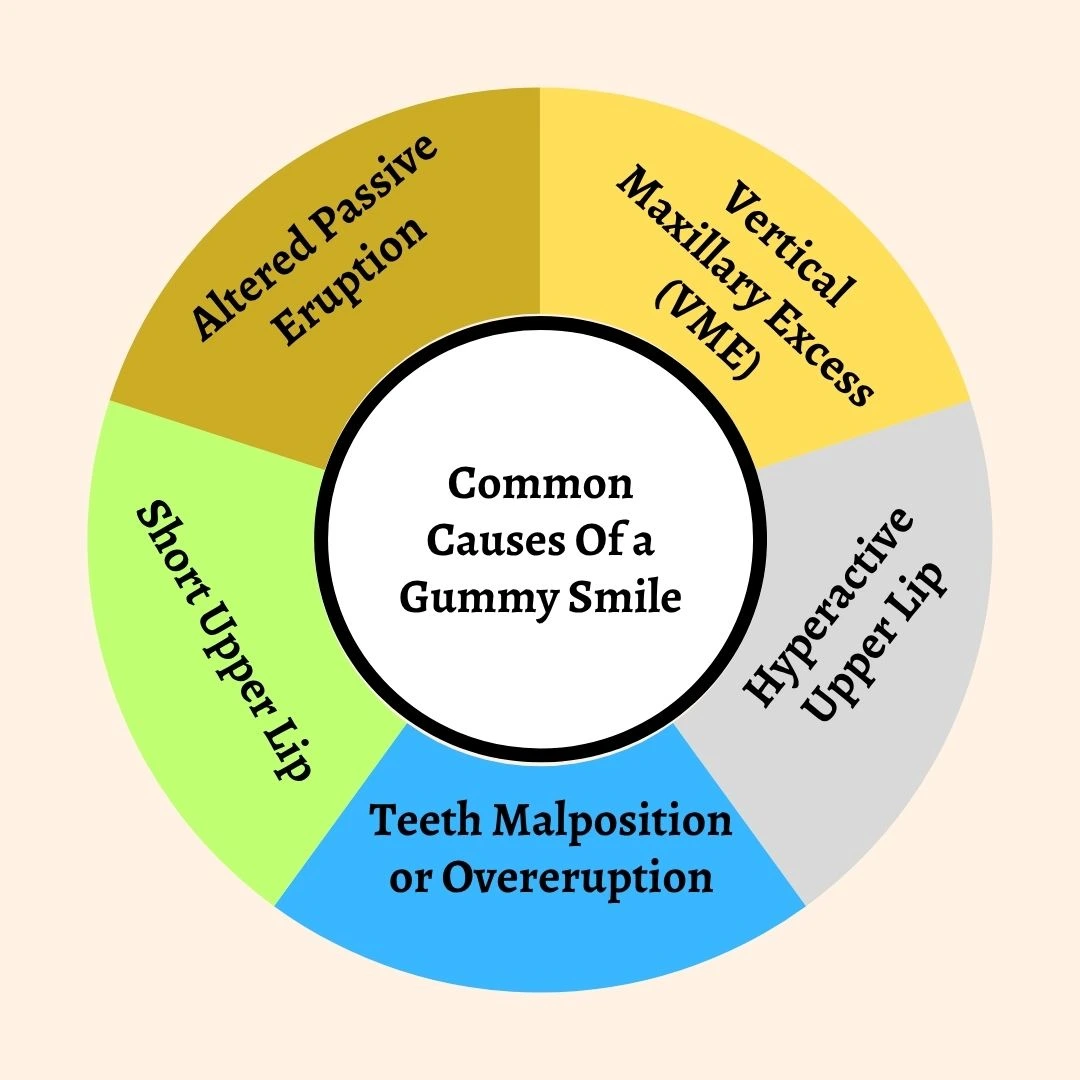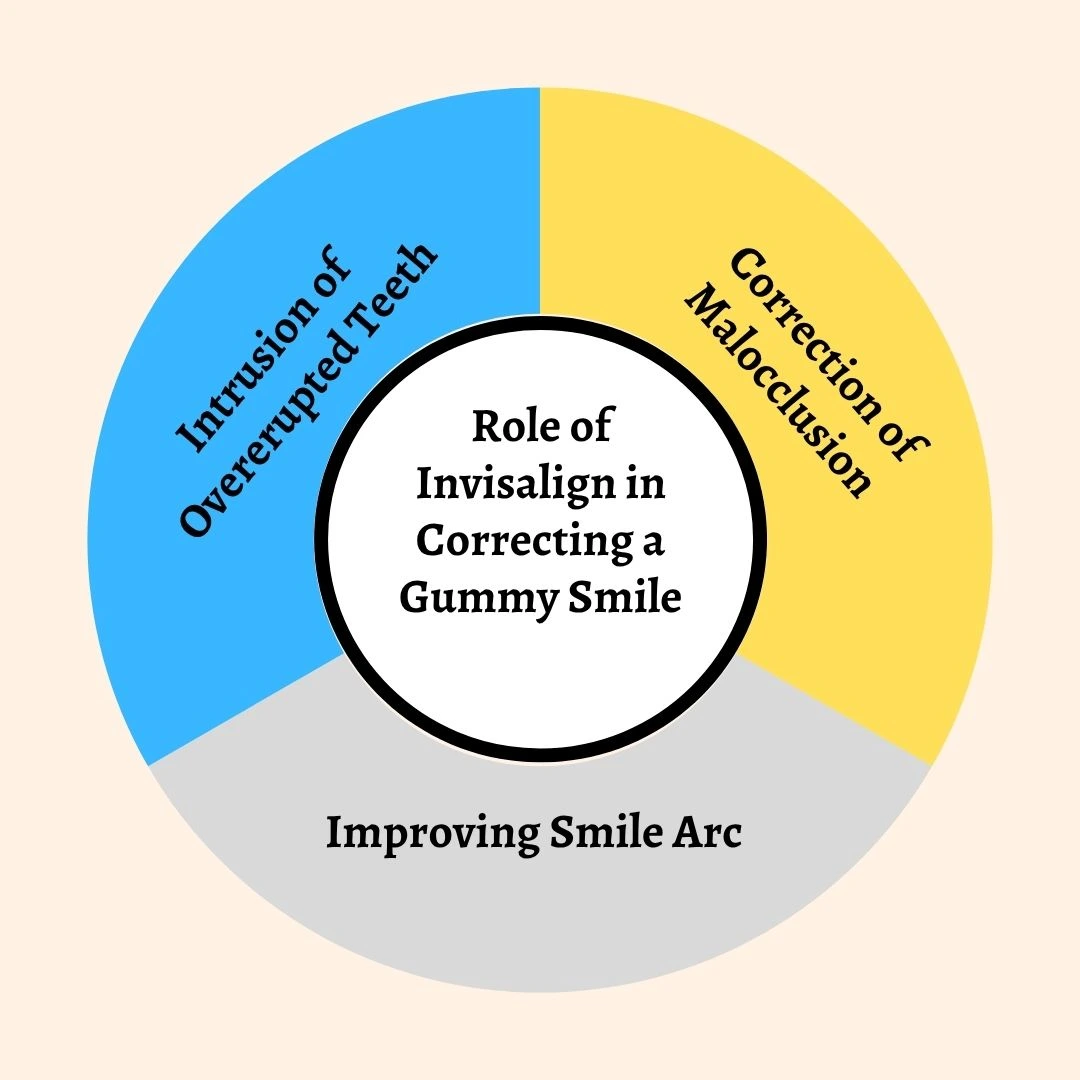
VISITING HOURS:
Week Days - 9 am to 8 pmSundays - Only Emergency Cases
Can Invisalign Fix a Gummy Smile?
Having a gummy smile is a common concern among patients, characterised by an excessive display of gum tissue when smiling. Although Invisalign is well-known for straightening teeth, advances in orthodontics have opened new possibilities for treating this condition. Thereby making one think: Can Invisalign be the solution for a gummy smile?
The answer depends on the underlying cause of the gummy smile. In this blog, we will explore the aetiology of gummy smiles, evaluate how Invisalign can contribute to treatment and discuss when adjunctive or alternative procedures might be needed.
What Does a Gummy Smile Refer To?
The technical term for gummy smile is excessive gingival display, which means 3–4 millimetres of gum crowns the tops of your upper teeth in a full smile. Though what makes a smile ‘gummy’ can differ depending on culture or just taste, it still creates real trouble for many patients because of its effect on facial balance and self-esteem.
Common Causes of a Gummy Smile

To find out if Invisalign treatment will suffice, it is necessary to learn what causes a gummy smile. Among the usual causes are:
Altered Passive Eruption
In some individuals, the teeth appear shorter due to incomplete exposure through the gums, giving the illusion of excessive gingival display. This condition often requires periodontal intervention for correction.
- Vertical Maxillary Excess (VME)
If the upper jaw grows too far upward, there will be more gum visible while talking and smiling. Most of the time, surgical treatment is required for the best effects.
- Hyperactive Upper Lip
In these cases, a wide smile displays more gum, even though the patient’s teeth and gums are within normal anatomical limits. Muscle hyperactivity can be managed with Botox or lip repositioning procedures.
- Teeth Malposition or Overeruption
If the upper teeth have overerupted due to a lack of opposing forces or other occlusal issues, they may bring the gums along with them, leading to a gummy smile. The answer is yes; in many such cases, orthodontic intrusion can help.
- Short Upper Lip
A naturally short upper lip may also contribute to excessive gingival display. While rare, this condition may be addressed with surgical or cosmetic approaches depending on severity and patient preference.
Also Read: Tips for Wearing Clear Aligners
The Role of Invisalign in Correcting a Gummy Smile

Thanks to Invisalign, people can straighten their teeth without the unappealing look of traditional braces. Invisalign treatment is mainly employed to treat occlusion problems, although it is just as effective in treating gummy smiles that arise from dental and orthodontic causes.
- Intrusion of Overerupted Teeth
In cases where a gummy smile is due to overeruption of the anterior maxillary teeth, Invisalign can be used to intrude the upper front teeth back into the alveolar bone. Such intrusion results in less gingival exposure with the actuated smile. Invisalign’s SmartForce attachments and optimised biomechanics allow for precise vertical tooth movement, making it a viable option for such corrections.
- Correction of Malocclusion
Malocclusion or misalignment can indirectly contribute to a gummy smile by altering the bite and the way lips and facial muscles interact during smiling. Invisalign effectively aligns the teeth and improves occlusion, which can lead to more balanced lip dynamics and improved smile aesthetics.
- Improving Smile Arc
Smile arc describes the common intra-arch trajectory between the lower lip and the contour of the maxillary incisal edge. A flat or reverse smile arc will further increase the gingival display. Invisalign treatment plans can be designed to enhance the smile arc through extrusion and intrusion of specific teeth, optimising aesthetic outcomes.
Also Read: How to Choose the Right Invisalign Orthodontist?
When Invisalign Alone May Not Be Enough
Although Invisalign is effective in treating gummy smiles from slightly protruding teeth, it cannot address gummy smiles that are caused by skeletal, soft tissue or other anatomical etiologies, such as:
- Vertical Maxillary Excess (VME)
Vertical Maxillary Excess (VME) is a dental and facial condition where the upper jaw (maxilla) is vertically overgrown. Severe VME usually requires surgical intervention, such as orthognathic surgery, to reposition the maxilla and reduce gingival display. In mild cases, Invisalign may be used adjunctively after or alongside surgery.
- Hyperactive Upper Lip
One of the common causes of a gummy smile is a hyperactive upper lip. Botulinum toxin (Botox) injections can temporarily reduce lip hyperactivity, while lip repositioning surgery offers a more permanent solution. Invisalign has no direct impact on lip mobility.
- Altered Passive Eruption
In such cases, crown lengthening procedures, either via laser or traditional periodontal surgery, are required to expose more of the clinical crown and reduce gingival display. Orthodontic treatments, including Invisalign, can be used to refine alignment.
Combining Invisalign With Other Treatments
For many patients, the most effective treatment for a gummy smile is multimodal, combining Invisalign with surgical, periodontal or cosmetic procedures. Some effective combinations include:
Invisalign + Crown Lengthening: To expose more tooth surface and correct alignment.
Invisalign + Botox: For patients with hyperactive lip elevator muscles.
Invisalign + Orthognathic Surgery: In severe skeletal discrepancies.
A thorough diagnostic workup, including clinical examination, cephalometric analysis, smile analysis and photographic record, is essential to determine the best course of action.
Clinical Case Example
Patient Profile: A 25-year-old female presents with concerns about excessive gum visibility when smiling.
Diagnosis: Mild vertical overeruption of upper anterior teeth, mild crowding, no skeletal abnormalities.
Treatment Plan:
12 months of Invisalign therapy with programmed intrusion of upper incisors.
Use of SmartForce attachments for anchorage.
Post-treatment gingival contouring for optimal results.
Outcome: Significant reduction in gingival display, improved smile arc and high patient satisfaction without the need for surgery.
Conclusion
Invisalign is a powerful orthodontic tool that can address many forms of malocclusion and dental aesthetic concerns, including certain types of gummy smiles. Otherwise, it is very much dependent on the aetiology of the gingival display.
As a dental professional, it is our responsibility to conduct a comprehensive diagnosis and educate patients about all available treatment options, whether orthodontic, surgical or cosmetic. Invisalign may be part of the solution or the solution itself, but it should always be integrated into a broader treatment strategy that prioritises function, health and aesthetics.
This requires careful assessment through clinical examination, imaging and often interdisciplinary collaboration. By understanding each patient’s unique anatomical and functional presentation, we can craft personalised treatment plans that not only improve smile aesthetics but also enhance long-term oral health and patient satisfaction. Dentique offers personalised Invisalign treatments to effectively correct such smile concerns with advanced technology and expert care.
For more assistance and guidance, get in touch with us.
OUR
TREATMENTS
TREATMENTS








